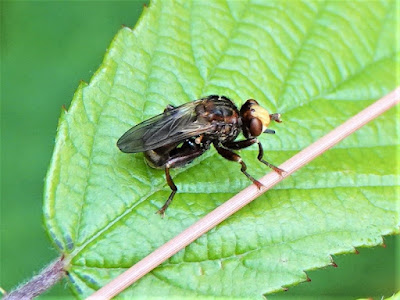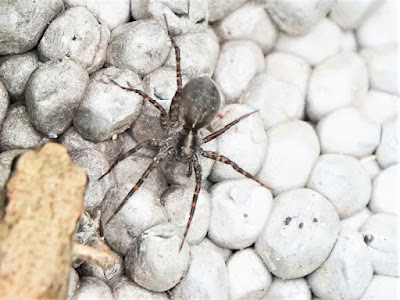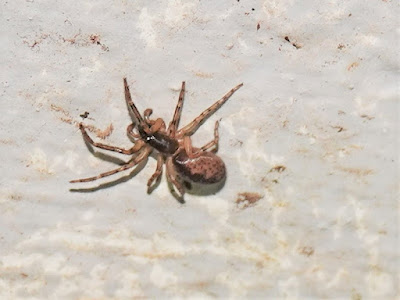Priorslee Balancing Lake and The Flash
15.0°C > 16.0°C: Early thick low cloud lifted with a very few breaks appearing. Moderate southerly breeze. Very good visibility.
Sunrise: 04:59 BST
* = a species photographed today
! = a new species for me here this year
!! = a new species for me in Shropshire
Priorslee Balancing Lake: 05:05 – 06:10 // 07:10 – 09:50
(149th visit of the year)
Bird notes:
- six Canada Geese flew North at 05:45: my first post-moulting sighting
- the brood of two Mallard ducklings seen again.
- 51 Black-headed Gulls (two of them juveniles) and three Lesser Black-backed Gulls (one a juvenile) were on the football field c.06:00.
- two Oystercatchers were on the south-west grass at 05:20. They flew off at 05:35 and were presumably the two seen on the football field c.06:00 and then back on the south-west grass at 07:25 before being flushed by dog-walkers.
- c.25 Swifts briefly descended from the low cloud over the West end at 05:20. Some of them were screaming which is unusual at this date. Perhaps juveniles?
- the four Barn Swallows were likely a family party with several food-passes noted.
- no Cetti's Warbler heard today.
- what was most likely a Willow Warbler was seen only fleetingly as it worked its way through the trees. It appeared much yellower than a Chiffchaff, looked slightly larger and moved more deliberately. It did not call.
- a Common Whitethroat was heard singing in a usual location c.09:15.
Counts of birds noted flying over:
- 6 Canada Geese: North together
- 2 Stock Dove: single and pair
- 155 Wood Pigeons
- 11 Lesser Black-backed Gulls
- 6 Jackdaws
- no Rooks
Hirundines etc. noted:
- c.25 Swifts: see notes
- 4 Barn Swallows
- 3 House Martins
Warblers noted (the figure in brackets relates to birds heard singing):
- 1? (0) Willow Warbler: see notes
- 15 (11) Chiffchaffs
- 8 (7) Reed Warblers
- 3 (3) Blackcaps
- 1 (1) Common Whitethroat
'nominal' warbler:
- 2 (2) Goldcrests
Counts from the lake area:
- 2 Mute Swans
- 12 (?♂) + 2 (1 brood) Mallard
- 4 + 3 (1 brood) Moorhens
- 32 + 9 (5 broods) Coots
- 4 Great Crested Grebes
- 1 Black-headed Gull: also 51 on the football field
- 1 Lesser Black-backed Gull: also three on the football field
- 1 Grey Heron
Noted on the street lamps poles pre-dawn:
Spiders:
- *1 Bridge Orb-web Spider Larinioides sclopetarius
Noted later:
- *1 Bridge Orb-web Spider Larinioides sclopetarius
Noted later:
Butterflies:
- Ringlet Aphantopus hyperantus
- Ringlet Aphantopus hyperantus
Moths:
- *Shaded Broad-bar Scotopteryx chenopodiata
- *Shaded Broad-bar Scotopteryx chenopodiata
Bees, wasps etc.:
- Garden Bumblebee Bombus hortorum
- Buff-tailed Bumblebee Bombus terrestris
- *female ichneumon Ichneumon sarcitorius
- Garden Bumblebee Bombus hortorum
- Buff-tailed Bumblebee Bombus terrestris
- *female ichneumon Ichneumon sarcitorius
Hoverflies
The first name is that used by Stephen Falk. The name in square brackets is that given by Obsidentify or other sources if different. Scientific names are normally common. The species are presented in alphabetic order of those scientific names.
- Marmalade Hoverfly Episyrphus balteatus
- Tapered Dronefly Eristalis pertinax
- Common Dronefly Eristalis tenax
- *Tiger Hoverfly Helophilus pendulus
- Chequered Hoverfly Melanostoma scalare [Long-winged Duskyface]
- Marmalade Hoverfly Episyrphus balteatus
- Tapered Dronefly Eristalis pertinax
- Common Dronefly Eristalis tenax
- *Tiger Hoverfly Helophilus pendulus
- Chequered Hoverfly Melanostoma scalare [Long-winged Duskyface]
Damsel-/dragon-flies:
- *Common Blue Damselfly Enallagma cyathigerum
- *Common Blue Damselfly Enallagma cyathigerum
Other flies:
- Black Snipefly Chrysopilus cristatus
- greenbottle Lucilia sp.
- *Muscid fly Phaonia tuguriorum
- semaphore fly Poecilobothrus nobilitatus
- *Yellow Dung Fly Scathophaga stercoraria
- *Thick-headed Fly Sicus ferrugineus [Ferruginous Bee-grabber]
- other unidentified flies
- Black Snipefly Chrysopilus cristatus
- greenbottle Lucilia sp.
- *Muscid fly Phaonia tuguriorum
- semaphore fly Poecilobothrus nobilitatus
- *Yellow Dung Fly Scathophaga stercoraria
- *Thick-headed Fly Sicus ferrugineus [Ferruginous Bee-grabber]
- other unidentified flies
Bugs etc.:
- *!!mirid bug, probably Apolygus spinolae
- Red Bug Deraeocoris ruber nymph
- *unidentified nymph
- *!!mirid bug, probably Apolygus spinolae
- Red Bug Deraeocoris ruber nymph
- *unidentified nymph
Beetles:
- *Common Red Soldier Beetle Rhagonycha fulva
- *Common Red Soldier Beetle Rhagonycha fulva
Molluscs:
- White-lipped Snail Cepaea hortensis
- White-lipped Snail Cepaea hortensis
Spiders etc.:
- *White Crab Spider Misumena vatia [Flower Spider]
- *wolf spider Pardosa sp.
- *harvestman: female Leiobunum rotundum
- *White Crab Spider Misumena vatia [Flower Spider]
- *wolf spider Pardosa sp.
- *harvestman: female Leiobunum rotundum
New flowers noted:
- none
- none
About as good as the weather became after the cloud lifted somewhat.
The two Oystercatchers on the football field. The right-hand bird seems to be trying to find food from the artificial cricket strip.
On the left an adult Black-headed Gull. The other two are juvenile Black-headed Gulls: they look very different! Within a few weeks the dark and often gingery-looking feathers will be replaced.
A Song Thrush with a beakful of healthy food for its off-spring's breakfast.
Any guesses at to what this is? It is a Wren's nest.
And here is one of the parents at the nest. Above the adult's bill is the gaping mouth of a nestling.
Feed us! Feed us!
A much better specimen of a Shaded Broad-bar moth Scotopteryx chenopodiata . Probably a male with feathered antennae.
I will have to pass on this moth. I have inverted the photo for easier viewing. Despite lying on the ground I was unable to get a better view of the wings.
This is a female ichneumon Ichneumon sarcitorius.
I had to double-check this Tiger Hoverfly Helophilus pendulus. It is paler than usual, almost lemon-coloured.
Common Blue Damselflies Enallagma cyathigerum seem to be the only damselflies around at the moment. This is a male.
This Yellow Dung Fly Scathophaga stercoraria is not yellow because it is a female.
A Thick-headed Fly Sicus ferrugineus.
This close-up view is not so well-focussed. It does show how this species sits with the tip of its abdomen tucked underneath.
This is a Muscid fly Phaonia tuguriorum. It seems to be blowing a bubble.
A mirid bug, probably Apolygus spinolae. I thought the legs were black-banded: in fact these are short spines.
A tiny nymph of a bug on one of my fingers. I am not very smooth-skinned these days!
A Common Red Soldier Beetle Rhagonycha fulva.
Exactly where I found it on Monday: a White Crab Spider Misumena vatia. You can even see the two rows of four eyes – most spiders have eight eyes with one family having only six.
A Bridge Orb-web Spider Larinioides sclopetarius in pursuit of a plumed midge in the spider's web. I have seen many fewer of this spider than usual this year.
A male wolf spider Pardosa sp. There was a female with him, as usual carrying an egg sac. She was running around so quickly I could not capture an acceptable photo.
I am not used to seeing harvestmen anywhere other than on the street lamp poles. The parallel sided dark area extending along the whole length of the saddle identifies this as a female Leiobunum rotundum.
(Ed Wilson)
In the Priorslee Avenue tunnel:
------------------------------------------------------------------------------------------------------
In the Priorslee Avenue tunnel:
Spider:
- *possibly Textrix denticulata
- *possibly Textrix denticulata
(Ed Wilson)
------------------------------------------------------------------------------------------------------
The Flash: 06:15 – 07:05
(152nd visit of the year)
Bird notes:
- the geese were crowding the East edge of the island and it was impossible to see the Coots clearly-enough to attempt a count.
Bird(s) noted flying over here:
None
Hirundines etc. noted:
- 2 Swifts
- 9 House Martins: all flew North
Warblers noted (the figure in brackets relates to birds heard singing):
- 4 (3) Chiffchaffs
- 2 (2) Blackcaps
'nominal' warbler:
- no Goldcrests
Noted on / around the water:
- 213 Canada Geese
- 70 Greylag Geese
- 1 Canada x Greylag Goose
- 2 + 3 (1 brood) Mute Swan
- 1 (0) Gadwall
- 13 Mallard: sexes not determined: where were they all?
- no Tufted Duck
- 3 Moorhens
- ? + 3 (3 broods) Coots: see notes
- 3 Great Crested Grebes
- 1 Black-headed Gull: arrived
- 1 Kingfisher
Noted elsewhere around The Flash:
Hirundines etc. noted:
- 2 Swifts
- 9 House Martins: all flew North
Warblers noted (the figure in brackets relates to birds heard singing):
- 4 (3) Chiffchaffs
- 2 (2) Blackcaps
'nominal' warbler:
- no Goldcrests
Noted on / around the water:
- 213 Canada Geese
- 70 Greylag Geese
- 1 Canada x Greylag Goose
- 2 + 3 (1 brood) Mute Swan
- 1 (0) Gadwall
- 13 Mallard: sexes not determined: where were they all?
- no Tufted Duck
- 3 Moorhens
- ? + 3 (3 broods) Coots: see notes
- 3 Great Crested Grebes
- 1 Black-headed Gull: arrived
- 1 Kingfisher
Noted elsewhere around The Flash:
Moths:
- *1 Engrailed Ectropis bistortata
- *1 Engrailed Ectropis bistortata
I think this moth is an Engrailed Ectropis bistortata. Obsidentify was very sure (92%) this was the VERY similar Small Engrailed E. crepuscularia. Reading my Field Guide I favour the former as the latter is not usually flying at this date. The size is not relevant as this would be a second generation Engrailed: these are, confusingly, smaller than either generation of the Small Engrailed.
(Ed Wilson)
(Ed Wilson)
------------------------------------------------------------------------------------------------------
Sightings from previous years
2009
Priorslee Lake
12 Swifts
1 Lesser Whitethroat
(Ed Wilson)
The Flash
3 Great Crested Grebes
201 Canada Geese
4 Tufted Duck
(Ed Wilson)
2007
Priorslee Lake
After 29 days the 5 remaining Mute Swan Cygnets are still going strong. Last year, as you may recall, we had 9 but ended up with just 1, after a Mink devastated the family. This year it has been Mink clear and even though we lost 2 within the first two days, these guys I think will do really well.
(Martin Adlam)
2009
Priorslee Lake
12 Swifts
1 Lesser Whitethroat
(Ed Wilson)
The Flash
3 Great Crested Grebes
201 Canada Geese
4 Tufted Duck
(Ed Wilson)
2007
Priorslee Lake
After 29 days the 5 remaining Mute Swan Cygnets are still going strong. Last year, as you may recall, we had 9 but ended up with just 1, after a Mink devastated the family. This year it has been Mink clear and even though we lost 2 within the first two days, these guys I think will do really well.
(Martin Adlam)
























